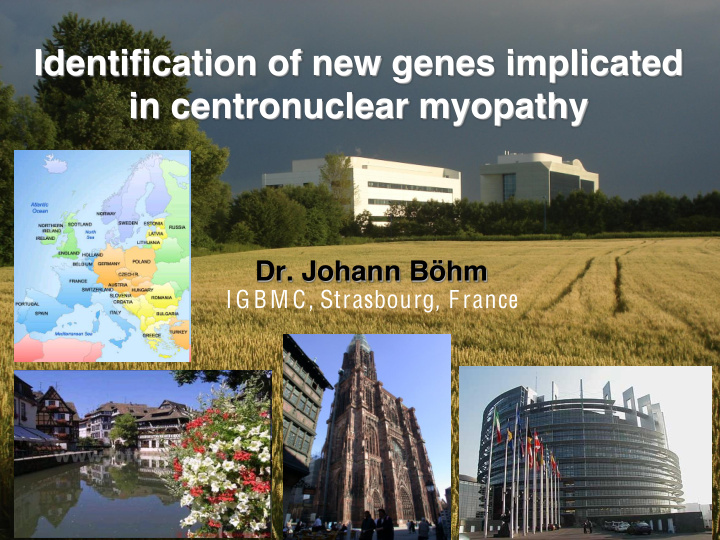



Identification of new genes implicated in centronuclear myopathy Dr. Johann Böhm IGBM C , Stra s bourg , Fran ce
Pati e nt Control XLCNM Autosomal Autosomal X-linked dominant recessive CNM (XLCNM) (ADCNM) (ARCNM) Severity / onset ++ / childhood + / adult +++ / neonatal Dynamin 2 Amphiphysin 2 Myotubularin Mutated protein (DNM2) (BIN1) (MTM1) (Laporte et al., (Nicot et al., (Bitoun et al., Nature Genet 1996) Nature Genet 2007) Nature Genet 2005)
Patients Therapeutic Molecular approaches diagnosis Functional Animal model investigations
Molecular diagnosis � Blood sample : DNA � Blood or skin : cells (DNA and protein) � Muscle biopsy : histology and proteins 500 patients received over the last 15 years: 300 mutated in MTM1 - myotubularin 50 mutated in DNM2 - dynamin 5 mutated in BIN1 - amphiphysin ~150 without known cause => Other unknown genes
Molecular diagnosis 120 families without mutation in MTM1/BIN1/DNM2 Functional candidates Positional candidates Implicated in membrane trafficking Linkage analysis Nuclear positioning (nuclear envelope) Interaction with CNM proteins Myopathies in other organisms Identification in 50% of patients with neuromuscular disorders Not applicable to small families or sporadic cases = no genetic counseling no therapeutic approach
Sanger sequencing (25 years): Gene by gene exploration 5 � /sequencing covering 500 nucleotides Next generation sequencing (since 2008): Whole genome / exome 30 million nucleotides/hour Analysis: a few days 5000 � /genome Ion Torrent (since 2011): 1 GB /2 hours Fast analysis (simple chemistry) 800-1000 � /run
1573 non-synonymous variations ; 345 insertions / deletions (indels) in coding sequences
Novel disease gene discovery Whole-genome, one family (two affected siblings Miller syndrome AR and both parents) Metachondromatosis AD Whole-genome, single proband Exome, four cases (two siblings, two other Miller syndrome AR unrelated) Schinzel � Giedion syndrome AD Exome, four unrelated cases Fowler syndrome AR Exome, two unrelated cases Kabuki syndrome AD Exome, 10 unrelated cases Joubert syndrome 2 AR Exomes of 2 related individuals Non-syndromic hearing loss (DFNB82) AR exome, single case TARP syndrome X X chromosome exons, two unrelated carriers Linkage interval + 2 candidate genes, single Familial exudative vitreoretinopathy AD proband Clericuzio-type poikiloderma with neutropenia AR Linkage interval, single case Sensory/motor neuropathy with ataxia AD Linkage interval, proband and both parents Non-syndromic deafness (DFNB79) AR Linkage interval, single case Clinical diagnosis Exome, single patient with suspected Congenital chloride-losing diarrhea AR Bartter syndrome Primary ciliary dyskinesia AR Exome, two siblings Molecular diagnosis Charcot � Marie � Tooth disease AR Whole-genome, single proband
Single Nucleotide Polymorphisms SNPs make up 90% of all human genetic variations, and SNPs with a minor allele frequency of at least 1% occur every 100 to 300 bases along the human genome, on average (how humans develop diseases, respond to pathogens, chemicals, drugs, etc.) Ranking � Exclude SNP (dbSNP et HapMap) � Rank by type (stop, splice, missense) � Rank by impact (e.g. missense variations in conserved domains?) Controls � Confirm variant by re-sequencing � Segregation in the family � Sequence appropriate control populations
Chromosome pairs http://www.eibe.info/ Sexual chromosomes = determine sex
XY XX XY XX XY XX X-linked centronuclear myopathy (MTM) 50% 50% XY XX XX http://www.simpsonspark.com/pictures_others1.php
19/19 19/19 19/19 19/19 19/19 19/19 Autosomal dominant CNM (DNM2) 19/19 19/19 19/19 http://www.simpsonspark.com/pictures_others1.php
2/2 2/2 2/2 2/2 2/2 2/2 Autosomal recessive CNM (BIN1) 66% 2/2 2/2 2/2 http://www.simpsonspark.com/pictures_others1.php
Jake � Onset at 3.5 months: weakness, muscle atrophy, lethargy, ventroflexed neck, arched spine, short choppy gait, collapsing after short distances � Routine serum biochemistry profiles unremarkable � Electromyography: abnormal spontaneous activity in several muscle groups
Aff ec t e d ATPa s e H & E NADH-TR Vastus lateralis cross sections: � Hypotrophic, round shaped fibers, central nuclei � Central and sub-sarcolemmal accumulations (necklace fibers) � Type 1 fiber predominance NADH-TR H & E ATPa s e Control
Exon 7: c.465C>A protein-protein interaction protein-lipid interaction GRAM-PH Phosphatase Coiled-coil PDZ-binding Affected male Obligate carrier All affected males hemizygous, all obligate carriers heterozygous Controls: - worldwide panel of 237 unrelated and unaffected Labrador retrievers - 59 control dogs from 25 other breeds
100 80 60 40 20 WT wild typ e N155K N155K N155K WT WT N155K 0 No aggregates >50 aggregates <50 aggregates N155K Proteasome Merge
Conclusions and Perspectives Conclusion � First MTM1 mutation identified in CNM in dogs � Classical clinical and histological CNM features Perspectives � Important for the scientific understanding of the pathogenesis of CNM � Pre-clinical therapeutic trials in rodent models cannot always be directly extrapolated to the human condition. � Labrador retriever represents an excellent model to establish therapeutic approaches for centronuclear myopathies
Thanks!
Recommend
More recommend